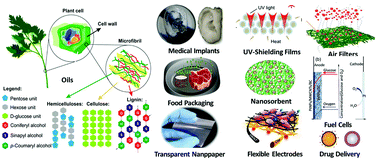Plant celluloses, hemicelluloses, lignins, and volatile oils for the synthesis of nanoparticles and nanostructured materials
Abstract
A huge variety of plants are harvested worldwide and their different constituents can be converted into a broad range of bionanomaterials. In parallel, much research effort in materials science and engineering is focused on the formation of nanoparticles and nanostructured materials originating from agricultural residues. Cellulose (40–50%), hemicellulose (20–40%), and lignin (20–30%) represent major plant ingredients and many techniques have been described that separate the main plant components for the synthesis of nanocelluloses, nano-hemicelluloses, and nanolignins with divergent and controllable properties. The minor components, such as essential oils, could also be used to produce non-toxic metal and metal oxide nanoparticles with high bioavailability, biocompatibility, and/or bioactivity. This review describes the chemical structure, the physical and chemical properties of plant cell constituents, different techniques for the synthesis of nanocelluloses, nanohemicelluloses, and nanolignins from various lignocellulose sources and agricultural residues, and the extraction of volatile oils from plants as well as their use in metal and metal oxide nanoparticle production and emulsion preparation. Furthermore, details about the formation of activated carbon nanomaterials by thermal treatment of lignocellulose materials, a few examples of mineral extraction from agriculture waste for nanoparticle fabrication, and the emerging applications of plant-based nanomaterials in different fields, such as biotechnology and medicine, environment protection, environmental remediation, or energy production and storage, are also included. This review also briefly discusses the recent developments and challenges of obtaining nanomaterials from plant residues, and the issues surrounding toxicity and regulation.

- This article is part of the themed collections: 2020 Nanoscale HOT Article Collection and Recent Review Articles


 Please wait while we load your content...
Please wait while we load your content...